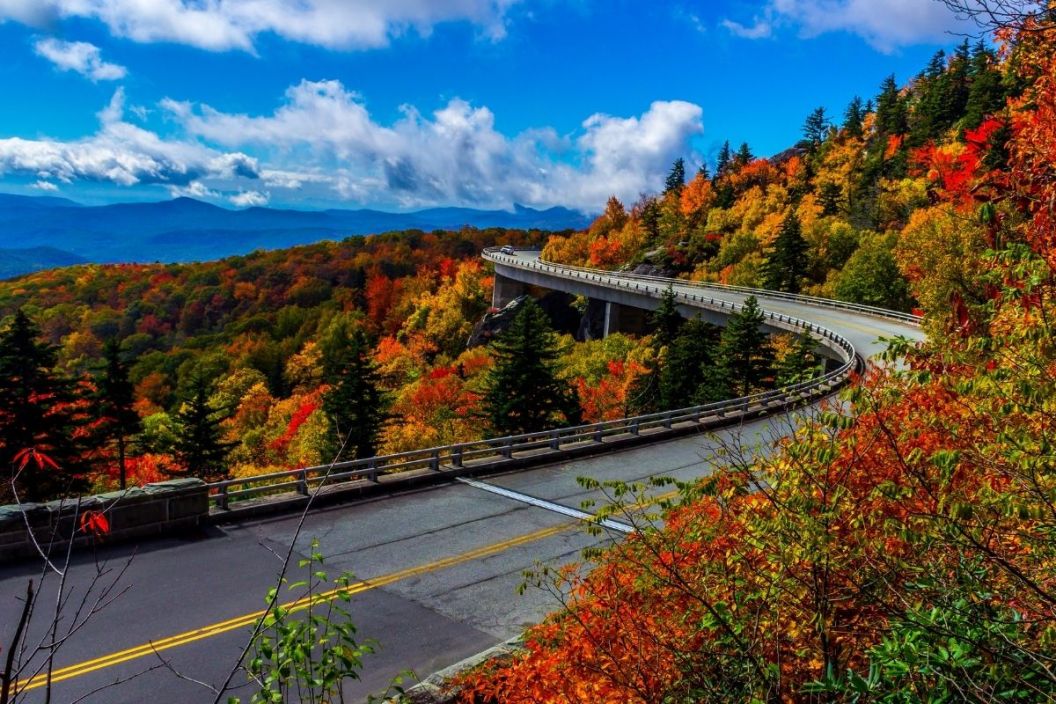Known as America's favorite drive, the Blue Ridge Parkway is the United States' longest linear park that stretches for 469 miles through the rolling hills of North Carolina and Virginia. This span of highway is the longest road planned as a single unit in the US and connects Shenandoah National Park to Great Smoky Mountains National Park. Featuring incredible vistas and public areas to explore, the Blue Ridge Parkway is the best way to discover the southern Appalachian landscapes and dense forests.
History of America's Scenic Drive
https://www.instagram.com/p/CO6K2w5JaSf/?utm_source=ig_web_copy_link
This land belongs to numerous Native tribes, including ?????? Tsalaguwetiyi (Cherokee, East), S'atsoyaha (Yuchi), Tutelo, Monacan, Saponi, and Lumbee. You can also learn about the Native history of the area at the Peaks of Otter Visitor Center museum (milepost 85.9). In the North Carolina region of the Parkway, you enter the Cherokee Indian Reservation at milepost 457.7. This area features an informational display on the reservation at the Lickstone Parking Overlook (milepost 458.9).
The Creation of the Blue Ridge Parkway
https://www.instagram.com/p/COJaASRAmoH/?utm_source=ig_web_copy_link
One of the first of its kind, the Blue Ridge Parkway was engineered to design into the landscape to provide a roadway simple for the pleasure of enjoying the scenery. Ranging from its low point at 649 feet at James River in Virginia to its highest point at 6,047 feet in Richland Balsam in North Carolina, this scenic parkway provides something for the adventurer in everyone!
The Parkway is said to be a "museum of the managed American countryside," which preserves the pioneer's log cabin, the textile worker's summer home, and traces of early colonization in America.
The Journey of Blue Ridge Parkway
https://www.instagram.com/p/CNxJqYLDi70/?utm_source=ig_web_copy_link
The Blue Ridge Parkway starts and ends in either the Cherokee area or the Roanoke and Afton area, depending on where you want to begin and how far you want to drive. Preserved by the National Park Service (NPS), the Parkway includes a whopping 91 buildings, 2 sites, and 133 other structures to discover. For the sake of the itinerary, we will begin this descriptive journey in Cherokee, Tennessee. This stretch of western North Carolina is the start of the Blue Ridge Mountains.
The Great Smoky Mountains National Park
https://www.instagram.com/p/CPa2jSXBQ6-/?utm_source=ig_web_copy_link
This incredible adventure begins in the town of Cherokee, North Carolina, in the Great Smoky Mountains National Park in the Pisgah Region of the Parkway (from milepost 339.5 to Milepost 469). As you head out on your journey, some of the first points of interest you will see are Big Witch Gap, Waterrock Knob, and Black Balsam Knob, before you reach the highest point in Richland Balsam.
Devil's Courthouse
This is a wonderful area to stop for a hike, as trailheads scatter the area and present incredible panoramic vistas. Out of the 40 peaks above 6,000 feet in North Carolina, Black Balsam Knob is the 23rd highest. Next up is the Devil's Courthouse. From the parking area at Milepost 422.4, you can take the steep, half-mile hike to a stunning vista where you can see North Carolina, South Carolina, Georgia, and Tennessee on a clear day!
Graveyard Fields & Mount Pisgah
https://www.instagram.com/p/CHXH1NkBr2c/?utm_source=ig_web_copy_link
At Milepost 418.8, you will arrive at Graveyard Fields, fitted with lots of hiking trails, as well as convenient bathroom facilities. There are waterfalls you can find along Yellowstone Prong, including the 3-mile Graveyard Fields loop to the Upper Falls.
Next on your parkway travels, you enter the Pisgah National Forest and see the wondrous Mount Pisgah. You can actually climb to the mountaintop starting from the trailhead at the far end of the Mount Pisgah Parking Area. It is a challenging include of 712 feet but the views of the French Broad River Valley and Shining Rock Wilderness are worth it!
Asheville, North Carolina
https://www.instagram.com/p/CPbeJ8fJtre/?utm_source=ig_web_copy_link
RELATED: Hiking Hanging Rock State Park is a Dream Come True
After your day of hikes and adventure, stop for the night in the vibrant city of Asheville. Full of art museums, delicious eateries, breweries, and natural parks, Asheville is a wonderful place to add to the travel guide on your Parkway road trip. On your way out of town, Blue Ridge Parkway attractions include the Folk Art Center and the Blue Ridge Parkway Visitor Center.
Craggy Gardens
https://www.instagram.com/p/COLwgLCFNzP/?utm_source=ig_web_copy_link
Named by the jagged, rock "crags" on these high-elevation summits, Craggy Gardens is the perfect place to go to see incredible florals and wildflowers. This treasure features pink and purple blooms of Catawba rhododendrons that usually flourish in June. If you miss the rhododendrons,you can still catch the violets, blackberry, May-apple, and Turkscap Lilies! These gardens are a fabulous place to stop as they offer an ADA-accessible picnic area at Milepost 367.6.
Mount Mitchell State Park & Little Switzerland
With the highest point east of the Mississippi at 6,684 feet, Mount Mitchell State Park was actually one of the nation's first to join the NPS. The park offers an easily accessible observation deck and spruce-fir forest trails that lead to marvelous viewpoints.
On your way to Little Switzerland, stop by the renowned Penland School of Crafts or visit the Museum of North Carolina Minerals. This quaint mountain village was named after its incredible vistas rolling through distant valleys and distant views reminiscent of the foothills of the Swiss Alps.
Crabtree Falls
https://www.instagram.com/p/CHVvK13sOXA/?utm_source=ig_web_copy_link
A wonderful place to camp for the night, the Crabtree Falls area boasts crabtree blossoms and other wildflowers in May, moderate hiking trails to the 60-foot falls, as well as multiple options for staying overnight. Picnic areas and restrooms are also open seasonally.
Linville Falls
Known as the "Grand Canyon of the Southern Appalachians," Linville Gorge is home to multiple hikes of all calibers, including the one to three-tiered Linville Falls. This is probably the most popular waterfall on the parkway and can see up to 350,000 visitors every year. This is also a wonderful place to camp for the night.
Linn Cove Viaduct & Grandfather Mountain State Park
https://www.instagram.com/p/CGKK2BRgC0M/?utm_source=ig_web_copy_link
Although the entire drive is optimum for seeing the breathtaking fall colors, this 7-mile section of the Parkway was completed in 1987. The Linn Cove Viaduct (a famous bridge) winds around the face of the sacred Grandfather Mountain. Learn more about it with a stop at the Linn Cove Visitor Center.
Blowing Rock & Boone
These two charming mountain towns offer attractions, dining, shopping, and outdoor recreation. The Blowing Rock itself provides amazing views and is named after the Native legend about the constant winds at this geographical location. Fifteen minutes north of Grandfather Mountain sits the charming city of Boone. Enjoy a pampering spa day, do some shopping, or stay a night in a historic hotel.
Fancy Gap
https://www.instagram.com/p/Bj7dpMhh2tu/?utm_source=ig_web_copy_link
Now you enter the gorgeous state of Virginia for the last leg of your Parkway travels. Carroll County Virginia is complete with refreshing mountain streams, more rolling vistas, golfing, shopping, and more dining.
Roanoke
This Virginian city is the largest metropolitan area along the Parkway and offers the prime fusion of small-city allure and big-city convenience. Stop by for a few nights to explore this cultural hub, visit one of the seasonal festivals, or catch a flight back home!
Humpback Rocks & Afton
https://www.instagram.com/p/CJy74V5saCj/?utm_source=ig_web_copy_link
Once you reach Afton, you can visit Humpback Rocks, a historic area rich in hiking trails and scenic beauty. If you are feeling extra adventurous, you can even take the 105-mile Skyline Drive through Shenandoah National Park.
Have you traveled through America's favorite scenic drive? Share your adventure on the Blue Ridge Parkway on our Wide Open Roads Facebook!




